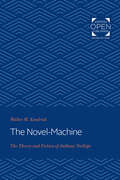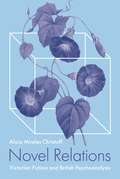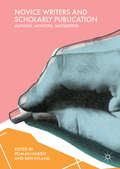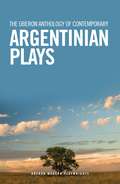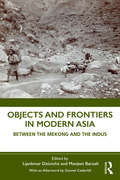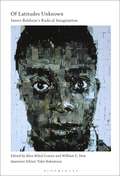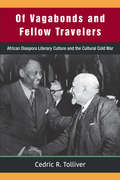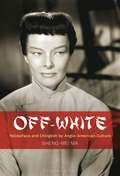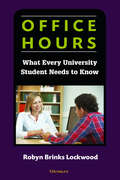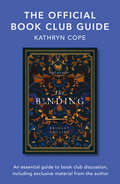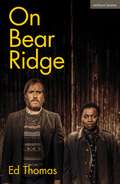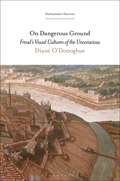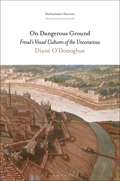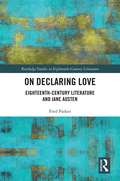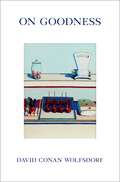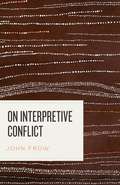- Table View
- List View
The Novel-Machine: The Theory and Fiction of Anthony Trollope
by Walter KendrickOriginally published in 1980. The first section of The Novel-Machine consists of five short chapters that rewrite Autobiography as an undisguised theory of realistic fiction, exploring its paradoxes while placing it in the context of mid-Victorian criticism. Chapters 6 and 7 survey the manifestations in Trollope's novels of what his theory sets down as the primary difference of realism: its way of telling its readers how to read. Chapter 8 is a close reading of He Knew He Was Right, a neglected novel that, in Kendrick's estimation, deserves to stand in much higher critical esteem than it does. Kendrick shows how deeply woven into the texture of Trollope's writing the rhetoric of realism is. Kendrick's reading is a departure from the usual method of criticizing Trollope—surveying the whole of his work a novel at a time, saying a little about every novel and always too little about each.
Novel Relations: Victorian Fiction and British Psychoanalysis
by Professor Alicia Mireles ChristoffNovel Relations engages twentieth-century post-Freudian British psychoanalysis in an unprecedented way: as literary theory. Placing the writing of figures like D. W. Winnicott, W. R. Bion, Michael and Enid Balint, Joan Riviere, Paula Heimann, and Betty Joseph in conversation with canonical Victorian fiction, Alicia Christoff reveals just how much object relations can teach us about how and why we read. These thinkers illustrate the ever-shifting impact our relations with others have on the psyche, and help us see how literary figures—characters, narrators, authors, and other readers—shape and structure us too. For Christoff, novels are charged relational fields.Closely reading novels by George Eliot and Thomas Hardy, Christoff shows that traditional understandings of Victorian fiction change when we fully recognize the object relations of reading. It is not by chance that British psychoanalysis illuminates underappreciated aspects of Victorian fiction so vibrantly: Victorian novels shaped modern psychoanalytic theories of psyche and relationality—including the eclipsing of empire and race in the construction of subject. Relational reading opens up both Victorian fiction and psychoanalysis to wider political and postcolonial dimensions, while prompting a closer engagement with work in such areas as critical race theory and gender and sexuality studies.The first book to examine at length the connections between British psychoanalysis and Victorian fiction, Novel Relations describes the impact of literary form on readers and on twentieth- and twenty-first-century theories of the subject.
Novel Relations: Victorian Fiction and British Psychoanalysis
by Professor Alicia Mireles ChristoffNovel Relations engages twentieth-century post-Freudian British psychoanalysis in an unprecedented way: as literary theory. Placing the writing of figures like D. W. Winnicott, W. R. Bion, Michael and Enid Balint, Joan Riviere, Paula Heimann, and Betty Joseph in conversation with canonical Victorian fiction, Alicia Christoff reveals just how much object relations can teach us about how and why we read. These thinkers illustrate the ever-shifting impact our relations with others have on the psyche, and help us see how literary figures—characters, narrators, authors, and other readers—shape and structure us too. For Christoff, novels are charged relational fields.Closely reading novels by George Eliot and Thomas Hardy, Christoff shows that traditional understandings of Victorian fiction change when we fully recognize the object relations of reading. It is not by chance that British psychoanalysis illuminates underappreciated aspects of Victorian fiction so vibrantly: Victorian novels shaped modern psychoanalytic theories of psyche and relationality—including the eclipsing of empire and race in the construction of subject. Relational reading opens up both Victorian fiction and psychoanalysis to wider political and postcolonial dimensions, while prompting a closer engagement with work in such areas as critical race theory and gender and sexuality studies.The first book to examine at length the connections between British psychoanalysis and Victorian fiction, Novel Relations describes the impact of literary form on readers and on twentieth- and twenty-first-century theories of the subject.
Novice Writers and Scholarly Publication: Authors, Mentors, Gatekeepers
by Ken Hyland Pejman HabibieThis book draws on the perspectives of authors, supervisors, reviewers and editors to present a rich, nuanced picture of the practices and challenges involved in writing for scholarly publication. Organized into four sections, it brings together international experts and junior scholars from a variety of disciplines to examine both publishing experiences and current research in the field. In doing so, it challenges the view that Native English speakers have a relatively easy ride in this process and that it is only English as an Additional Language (EAL) scholars who experience difficulties. The volume highlights central themes of writing for publication, including mentoring and collaborative writing, the writing experience, text mediation, the review process, journal practices and editorial decision-making, and makes a strong case for taking a more inclusive approach to research in this domain. This edited collection will appeal to students and scholars of applied linguistics, English for academic purposes, academic writing, and second language writing.
The Oberon Anthology of Contemporary Argentinian Plays (Oberon Modern Playwrights)
by Catherine BoyleFrom Ushuaia, the southernmost town in the world to the edges of the great Paraná river, and from the city of Buenos Aires to its fertile plains and the estuaries of northern Argentina, The Oberon Anthology of Contemporary Argentinian Plays provides a unique insight into the preoccupations and the creative responses of one of the major theatre-producing countries in Latin America. Includes the plays: La vida extraordinaria (Extraordinary Life) by Mariano Tenconi Blanco, translated by Catherine Boyle Pato verde (Green Duck) by Fabián Miguel Díaz, translated by Gwen MacKeith Fonavi by Leonel Giacometto, translated by Rosalind Harvey Nou Fiuter (No Future) by Franco Calluso, translated by William Gregory Poema ordinario (Poor Men’s Poetry) by Juan Ignacio Fernández, translated by William Gregory Fuego de dragón sobre dragón de madera (Dragon Fire over Wood Dragon) by Candelaria Sabagh, translated by Kate Eaton
Objects and Frontiers in Modern Asia: Between the Mekong and the Indus
by Lipokmar Dzüvichü Manjeet BaruahFocusing on the geographies between the Mekong and the Indus, this book brings objects to the centre of enquiry in the understanding of modern Asian frontiers. It explores how a range of objects have historically been significant bearers and agents of frontier making. For instance, how are objects connected to aspects of state making, social change, everyday life, diplomacy, political and ecological worlds, capital, forms of violence, resistances, circulations, and aesthetic expressions? This book seeks to interrogate and understand the dynamism of frontiers from the vantage point of objects such as salt, rubber, tea, guns, silk scarves, horses, and opium. It attempts to explore objects as sites of encounter, mediation, or dislocation between the social and the spatial. The book not only locates objects in the specificities of frontier spaces, but it also looks at how they are produced, circulated, and come to be intricately linked to a wide range of people, institutions, networks, and geographies. In the process, it explores how objects traverse and come to inhabit multiple historical, cultural, and geographical scales. This book will be of interest to researchers and academics working in areas of history, social and cultural anthropology, Asian studies, frontiers and borderland studies, cultural studies, political and economic studies, and museum studies.
Objects and Frontiers in Modern Asia: Between the Mekong and the Indus
by Lipokmar Dzüvichü Manjeet BaruahFocusing on the geographies between the Mekong and the Indus, this book brings objects to the centre of enquiry in the understanding of modern Asian frontiers. It explores how a range of objects have historically been significant bearers and agents of frontier making. For instance, how are objects connected to aspects of state making, social change, everyday life, diplomacy, political and ecological worlds, capital, forms of violence, resistances, circulations, and aesthetic expressions? This book seeks to interrogate and understand the dynamism of frontiers from the vantage point of objects such as salt, rubber, tea, guns, silk scarves, horses, and opium. It attempts to explore objects as sites of encounter, mediation, or dislocation between the social and the spatial. The book not only locates objects in the specificities of frontier spaces, but it also looks at how they are produced, circulated, and come to be intricately linked to a wide range of people, institutions, networks, and geographies. In the process, it explores how objects traverse and come to inhabit multiple historical, cultural, and geographical scales. This book will be of interest to researchers and academics working in areas of history, social and cultural anthropology, Asian studies, frontiers and borderland studies, cultural studies, political and economic studies, and museum studies.
Objects and Frontiers in Modern Asia: Between the Mekong and the Indus
by Lipokmar Dzüvichü Manjeet BaruahFocusing on the geographies between the Mekong and the Indus, this book brings objects to the centre of enquiry in the understanding of modern Asian frontiers. It explores how a range of objects have historically been significant bearers and agents of frontier making. For instance, how are objects connected to aspects of state making, social change, everyday life, diplomacy, political and ecological worlds, capital, forms of violence, resistances, circulations, and aesthetic expressions? This book seeks to interrogate and understand the dynamism of frontiers from the vantage point of objects such as salt, rubber, tea, guns, silk scarves, horses, and opium. It attempts to explore objects as sites of encounter, mediation, or dislocation between the social and the spatial. The book not only locates objects in the specificities of frontier spaces, but it also looks at how they are produced, circulated, and come to be intricately linked to a wide range of people, institutions, networks, and geographies. In the process, it explores how objects traverse and come to inhabit multiple historical, cultural, and geographical scales. This book will be of interest to researchers and academics working in areas of history, social and cultural anthropology, Asian studies, frontiers and borderland studies, cultural studies, political and economic studies, and museum studies.
Of Latitudes Unknown: James Baldwin's Radical Imagination
by Alice Mikal Craven William E. Dow Yoko NakamuraOf Latitudes Unknown is a multi-faceted study of James Baldwin's radical imagination. It is a selective and thoughtful survey that re-investigates the grounds of Baldwin studies and provides new critical approaches, subjects, and orientations for Baldwin criticism. This volume joins recent critical collections in “un-fragmenting” Baldwin and establishing further conjunctions in his work: the essay and the novel; the polemical and the aesthetic; his use of and participation in visual forms; and his American as well as international identities. But it goes beyond other recent studies by focusing on new entities of Baldwin's radical imagination: his English and French language selves; his late encounters with Africa; his appearances on French television and interviews with French journalists; and his unrecognized literary journalism. Of Latitudes Unknown also addresses Baldwin's relations with the Arab world, his anticipation of contemporary film and media studies, and his paradoxical public intellectualism. As it reassesses Baldwin's contributions to and influences on world literary history, Of Latitudes Unknown equally explores why the critical appreciation of Baldwin's writing continues to flourish, and why it remains a vast territory whose parts lie open to much deeper exploration and elaboration.
Of Vagabonds and Fellow Travelers: African Diaspora Literary Culture and the Cultural Cold War (Class : Culture)
by Cedric TolliverOf Vagabonds and Fellow Travelers recovers the history of the writers, artists, and intellectuals of the African diaspora who, witnessing a transition to an American-dominated capitalist world-system during the Cold War, offered searing critiques of burgeoning U.S. hegemony. Cedric R. Tolliver traces this history through an analysis of signal events and texts where African diaspora literary culture intersects with the wider cultural Cold War, from the First Congress of Black Writers and Artists organized by Francophone intellectuals in September 1956 to the reverberations among African American writers and activists to the assassination of Patrice Lumumba. Among Tolliver’s subjects are Caribbean writers Jacques Stephen Alexis, George Lamming, and Aimé Césaire, the black press writing of Alice Childress and Langston Hughes, and the ordeal of Paul Robeson, among other topics. The book’s final chapter highlights the international and domestic consequences of the cultural Cold War and discusses their lingering effects on our contemporary critical predicament.
Off-White: Yellowface and Chinglish by Anglo-American Culture
by Sheng-mei MaHow do English-speaking novelists and filmmakers tell stories of China from a Chinese perspective? How do they keep up appearances of pseudo-Sino immanence while ventriloquizing solely in the English language? Anglo writers and their readers join in this century-old game of impersonating and dubbing Chinese. Throughout this wish fulfillment, writers lean on grammatical and conceptual frameworks of their mother tongue to represent an alien land and its yellowface aliens. Off-white or yellow-ish characters and their foreign-sounding speech are thus performed in Anglo-American fiction and visual culture; both yellowface and Chinglish are of, for, by the (white) people.Off-White interrogates seminal Anglo-American fiction and film on off-white bodies and voices. It commences with one Nobel laureate, Pearl Buck, and ends with another, Kazuo Ishiguro, almost a century later. The trajectory in between illustrates that the detective and mystery genres continue unabated their stock yellowface characters, who exude a magnetic field so powerful as to pull in Japanese anime. This universal drive to fashion a foil is ingrained in any will to power, so much so that even millennial China creates an “off-yellow,” darker-hued Orient in Huallywood films to silhouette its global ascent.
Office Hours: What Every University Student Needs to Know
by Robyn Brinks LockwoodThe university office hour interaction is new to everyone who attends a university. Not knowing what to do or when to go is not unique to international students. Office Hours: What Every University Student Needs to Know sets out to demystify the entire process of office hours—the purpose and goals of these meetings, how to plan for them, and even determining whether to visit the professor or send an email. Information about “group” office hours, which are becoming more common, is also included. This task-based book also describes the five moves, or parts, of an office hour interaction and provides many examples and tasks to help guide students through this important communicative aspect of academic life. It seeks to ensure that every office hour interaction ends on a positive note. Reflection questions for new teaching assistants are included throughout, making this ideal for TA workshops. Four analysis tasks are included to accompany the four videos that explore various student-professor interactions. The videos are available online at www.press.umich.edu/elt/compsite/officehours.
The Official Book Club Guide: The Binding
by Kathryn CopeAn essential tool for all reading groups – a detailed guide to exciting debut novel, The Binding!
On Bear Ridge (Modern Plays)
by Ed ThomasOne minute we had customers, the next minute there was no-one.In a lost village, blurred by redrawn borders, hidden under a crumb on the map, Bear Ridge Stores still stands.After a hundred years, the family butchers and grocers – a place for odds and ends, contraband goods, and the last petrol pump for 30 miles – is now silent. But owners John Daniel and Noni are not leaving.They are defiantly drinking the remaining whiskey and remembering good times, when everyone was on the same side and the old language shone. Outside in the dark, a figure is making their way towards them.A semi-autobiographical story about the places we leave behind, the indelible marks they make on us, and the unreliable memories we hold onto.
On Dangerous Ground: Freud’s Visual Cultures of the Unconscious (Psychoanalytic Horizons)
by Diane O'DonoghueIn the final years of the 19th century, Sigmund Freud began to construct evidence for the workings of an “unconscious.” On Dangerous Ground offers an innovative assessment of the complex role that his encounters with visual cultures-architecture, objects from earlier cultural epochs (“antiquities”), paintings, and illustrated books-played in that process. Diane O'Donoghue introduces, often using unpublished archival sources, the ways in which material phenomena profoundly informed Freud's decisions about what would, and would not, constitute the workings of an inner life. By returning to view content that Freud treated as forgettable, as distinct from repressed, O'Donoghue shows us a realm of experiences that Freud wished to remove from psychical meaning. These erasures form an amnesic core within Freud's psychoanalytic project, an absence that includes difficult aspects of his life narrative, beginning with the dislocations of his early childhood that he declared “not worth remembering.” What is made visible here is far from the inconsequential surface of experience; rather, we are shown a dangerous ground that exceeds the limits of what Freud wished to include within his early model of mind. In Freud's relation to visual cultures we find clues to what he attempted, in crafting his unconscious, to remove from sight.
On Dangerous Ground: Freud’s Visual Cultures of the Unconscious (Psychoanalytic Horizons)
by Diane O'DonoghueIn the final years of the 19th century, Sigmund Freud began to construct evidence for the workings of an “unconscious.” On Dangerous Ground offers an innovative assessment of the complex role that his encounters with visual cultures-architecture, objects from earlier cultural epochs (“antiquities”), paintings, and illustrated books-played in that process. Diane O'Donoghue introduces, often using unpublished archival sources, the ways in which material phenomena profoundly informed Freud's decisions about what would, and would not, constitute the workings of an inner life. By returning to view content that Freud treated as forgettable, as distinct from repressed, O'Donoghue shows us a realm of experiences that Freud wished to remove from psychical meaning. These erasures form an amnesic core within Freud's psychoanalytic project, an absence that includes difficult aspects of his life narrative, beginning with the dislocations of his early childhood that he declared “not worth remembering.” What is made visible here is far from the inconsequential surface of experience; rather, we are shown a dangerous ground that exceeds the limits of what Freud wished to include within his early model of mind. In Freud's relation to visual cultures we find clues to what he attempted, in crafting his unconscious, to remove from sight.
On Declaring Love: Eighteenth-Century Literature and Jane Austen (Routledge Studies in Eighteenth-Century Literature)
by Fred Parker"What did she say? – Just what she ought, of course. A lady always does." This book explores the act of declaring love in works of literature written between the middle of the eighteenth century and the death of Jane Austen - and uncovers the uncertain boundaries of the self in the force-field of courtship. Declaring love is understood as the hazardous attempt to find public, social terms which can communicate personal feelings and bring intimacy into being. This was a period highly sensitive to the propriety and artificiality of public forms, and hence peculiarly alive to problems around the idea of saying what you feel, problems experienced especially though not exclusively by women. Through this historical lens the author considers the ways in which we may become entangled with one another through language, the limits to our operation as independent individuals, and whether in love you can only feel what you can tell. The first part of the book examines eighteenth-century attitudes towards the independent or disengaged self, performance culture, and the feasibility of sincerity, through readings of a wide range of different works. This provides the basis for a discussion of Austen's novels in the final two chapters, focused on the dynamics of courtship and the moment of proposal, and making much of the role of Austen's narrative voice in supporting the subjectivity of the one in love.
On Declaring Love: Eighteenth-Century Literature and Jane Austen (Routledge Studies in Eighteenth-Century Literature)
by Fred Parker"What did she say? – Just what she ought, of course. A lady always does." This book explores the act of declaring love in works of literature written between the middle of the eighteenth century and the death of Jane Austen - and uncovers the uncertain boundaries of the self in the force-field of courtship. Declaring love is understood as the hazardous attempt to find public, social terms which can communicate personal feelings and bring intimacy into being. This was a period highly sensitive to the propriety and artificiality of public forms, and hence peculiarly alive to problems around the idea of saying what you feel, problems experienced especially though not exclusively by women. Through this historical lens the author considers the ways in which we may become entangled with one another through language, the limits to our operation as independent individuals, and whether in love you can only feel what you can tell. The first part of the book examines eighteenth-century attitudes towards the independent or disengaged self, performance culture, and the feasibility of sincerity, through readings of a wide range of different works. This provides the basis for a discussion of Austen's novels in the final two chapters, focused on the dynamics of courtship and the moment of proposal, and making much of the role of Austen's narrative voice in supporting the subjectivity of the one in love.
ON GOODNESS C
by David Conan WolfsdorfOn Goodness attempts to answer the question "What is goodness?" It is natural to associate this question with ethics; but goodness is not confined to ethics. Water and wine, a strategy for streamlining maintenance operations, and an oil painting may all be good and in non-ethical ways. Goodness figures prominently in ethics; so the study serves ethics. But it serves other domains as well. On Goodness is a contribution to the foundations of value theory. It is also a metaphysical inquiry, for two reasons. As the examples indicate, the entity under investigation is extremely general. Goodness occurs in potables, plans, and paintings, among countless other kinds of things. Second, it is particularly obscure what sort of being the entity is. Besides the description "good," is there a single thing that good drinks, strategies, and artworks share? Is their goodness related in a more complex way? And regardless of these relations, in any instance, just what is that goodness? The question "What is goodness?" has been central to philosophy since Socrates and Plato made it their polestar. The distinctive contribution of On Goodness lies in its methodology. The method of pursuing the metaphysical question is linguistic. The basic proposal is that achieving the answer depends on clarifying the meaning and use of the words "good" and "goodness." Consequently, the study is pervasively informed by and critically engaged with contemporary linguistic theories and ideas.
On Interpretive Conflict
by John Frow“Interpretation” is a term that encompasses both the most esoteric and the most fundamental activities of our lives, from analyzing medical images to the million ways we perceive other people’s actions. Today, we also leave interpretation to the likes of web cookies, social media algorithms, and automated markets. But as John Frow shows in this thoughtfully argued book, there is much yet to do in clarifying how we understand the social organization of interpretation. On Interpretive Conflict delves into four case studies where sharply different sets of values come into play—gun control, anti-Semitism, the religious force of images, and climate change. In each case, Frow lays out the way these controversies unfold within interpretive regimes that establish what counts as an interpretable object and the protocols of evidence and proof that should govern it. Whether applied to a Shakespeare play or a Supreme Court case, interpretation, he argues, is at once rule-governed and inherently conflictual. Ambitious and provocative, On Interpretive Conflict will attract readers from across the humanities and beyond.
On Interpretive Conflict
by John Frow“Interpretation” is a term that encompasses both the most esoteric and the most fundamental activities of our lives, from analyzing medical images to the million ways we perceive other people’s actions. Today, we also leave interpretation to the likes of web cookies, social media algorithms, and automated markets. But as John Frow shows in this thoughtfully argued book, there is much yet to do in clarifying how we understand the social organization of interpretation. On Interpretive Conflict delves into four case studies where sharply different sets of values come into play—gun control, anti-Semitism, the religious force of images, and climate change. In each case, Frow lays out the way these controversies unfold within interpretive regimes that establish what counts as an interpretable object and the protocols of evidence and proof that should govern it. Whether applied to a Shakespeare play or a Supreme Court case, interpretation, he argues, is at once rule-governed and inherently conflictual. Ambitious and provocative, On Interpretive Conflict will attract readers from across the humanities and beyond.
On Interpretive Conflict
by John Frow“Interpretation” is a term that encompasses both the most esoteric and the most fundamental activities of our lives, from analyzing medical images to the million ways we perceive other people’s actions. Today, we also leave interpretation to the likes of web cookies, social media algorithms, and automated markets. But as John Frow shows in this thoughtfully argued book, there is much yet to do in clarifying how we understand the social organization of interpretation. On Interpretive Conflict delves into four case studies where sharply different sets of values come into play—gun control, anti-Semitism, the religious force of images, and climate change. In each case, Frow lays out the way these controversies unfold within interpretive regimes that establish what counts as an interpretable object and the protocols of evidence and proof that should govern it. Whether applied to a Shakespeare play or a Supreme Court case, interpretation, he argues, is at once rule-governed and inherently conflictual. Ambitious and provocative, On Interpretive Conflict will attract readers from across the humanities and beyond.
On Interpretive Conflict
by John Frow“Interpretation” is a term that encompasses both the most esoteric and the most fundamental activities of our lives, from analyzing medical images to the million ways we perceive other people’s actions. Today, we also leave interpretation to the likes of web cookies, social media algorithms, and automated markets. But as John Frow shows in this thoughtfully argued book, there is much yet to do in clarifying how we understand the social organization of interpretation. On Interpretive Conflict delves into four case studies where sharply different sets of values come into play—gun control, anti-Semitism, the religious force of images, and climate change. In each case, Frow lays out the way these controversies unfold within interpretive regimes that establish what counts as an interpretable object and the protocols of evidence and proof that should govern it. Whether applied to a Shakespeare play or a Supreme Court case, interpretation, he argues, is at once rule-governed and inherently conflictual. Ambitious and provocative, On Interpretive Conflict will attract readers from across the humanities and beyond.
On Interpretive Conflict
by John Frow“Interpretation” is a term that encompasses both the most esoteric and the most fundamental activities of our lives, from analyzing medical images to the million ways we perceive other people’s actions. Today, we also leave interpretation to the likes of web cookies, social media algorithms, and automated markets. But as John Frow shows in this thoughtfully argued book, there is much yet to do in clarifying how we understand the social organization of interpretation. On Interpretive Conflict delves into four case studies where sharply different sets of values come into play—gun control, anti-Semitism, the religious force of images, and climate change. In each case, Frow lays out the way these controversies unfold within interpretive regimes that establish what counts as an interpretable object and the protocols of evidence and proof that should govern it. Whether applied to a Shakespeare play or a Supreme Court case, interpretation, he argues, is at once rule-governed and inherently conflictual. Ambitious and provocative, On Interpretive Conflict will attract readers from across the humanities and beyond.
On Interpretive Conflict
by John Frow“Interpretation” is a term that encompasses both the most esoteric and the most fundamental activities of our lives, from analyzing medical images to the million ways we perceive other people’s actions. Today, we also leave interpretation to the likes of web cookies, social media algorithms, and automated markets. But as John Frow shows in this thoughtfully argued book, there is much yet to do in clarifying how we understand the social organization of interpretation. On Interpretive Conflict delves into four case studies where sharply different sets of values come into play—gun control, anti-Semitism, the religious force of images, and climate change. In each case, Frow lays out the way these controversies unfold within interpretive regimes that establish what counts as an interpretable object and the protocols of evidence and proof that should govern it. Whether applied to a Shakespeare play or a Supreme Court case, interpretation, he argues, is at once rule-governed and inherently conflictual. Ambitious and provocative, On Interpretive Conflict will attract readers from across the humanities and beyond.
